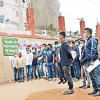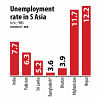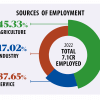Fall in jobless rate raises questions

The number of unemployed people in Bangladesh declined by 1.80 lakh year-on-year in the third quarter of 2023 despite the country's major economic indicators having slowed down.
The total number of unemployed people stood at 24.30 lakh in the July-September period of 2023, down from 26.10 lakh in the same period last year, according to the quarterly Labour Force Survey of the Bangladesh Bureau of Statistics (BBS).
The number of unemployed people stood at 25 lakh in the second quarter of 2023.
"It is hard to explain how employment has increased when every indicator has slowed," said Zahid Hussain, former lead economist of the World Bank's Dhaka office.
He said industrial import growth has declined significantly alongside other indicators, raising questions about the rise in employment in this area.
"The economy's major indicators, including export growth, remittance and credit growth have slowed during the third quarter of 2023. So, it's puzzling," he said.
During the July-September period, the opening of letters of credit (LCs) dropped by 18 percent and settlements declined by 25 percent year-on-year, according to Bangladesh Bank, providing a glimpse of slowing economic activities.
According to the BBS, the total labour force amounted to 7.10 crore in the third quarter in 2023, a year-on-year increase of around 9 lakh.
It is hard to explain how employment has increased when every economic indicator has slowed.
Workforce in the agriculture sector declined by 10 lakh while increasing by 14.80 lakh in the service sector and 3.8 lakh in the industrial sector.
Rizwanul Islam, an economist and former special adviser for the employment sector at the International Labour Office in Geneva, welcomed the rise in employment in the industrial sector.
"The rise in industrial employment is still lower than in the second quarter of 2023. But since it happened in manufacturing, that is good," he said.
Both the number of unemployed people and the rate of unemployment declined between the third quarter of 2022 and 2023.
However, Islam opined that the definition and measure of unemployment that was used did not reflect the real situation of the labour market in Bangladesh.
"The reported fall in unemployment would be good news if it reflected the real situation of the labour market," he said. "However, in countries like Bangladesh this is not the case."
He added that the absence of unemployment benefits meant people, especially poorer people, had little alternative to working -- even if it is just something to eke out a living somehow.
"A large number of the employed people in the country fall into that category. So, a slight fall or rise in this category is not of much significance," he said.
"The decline in unemployment has also been accompanied by a rise in the number outside the labour force. Is that due to a lack of jobs discouraging working age people from looking for jobs? Or are more people going into education?"
He added that the number of unemployed women has not fallen and that the unemployment rate among women had increased slightly.
The unemployment rate among women stood at 3.26 percent, up from 3.24 percent year-on-year.
He added that labour force participation rate fell in the case of women whereas it rose for men.
The reasons for this divergence need to be investigated and appropriate policies undertaken, he said.
"This is a trend that has been observed for some time. It's important to seriously look into this issue -- both in research and policy-making."


 For all latest news, follow The Daily Star's Google News channel.
For all latest news, follow The Daily Star's Google News channel. 








Comments